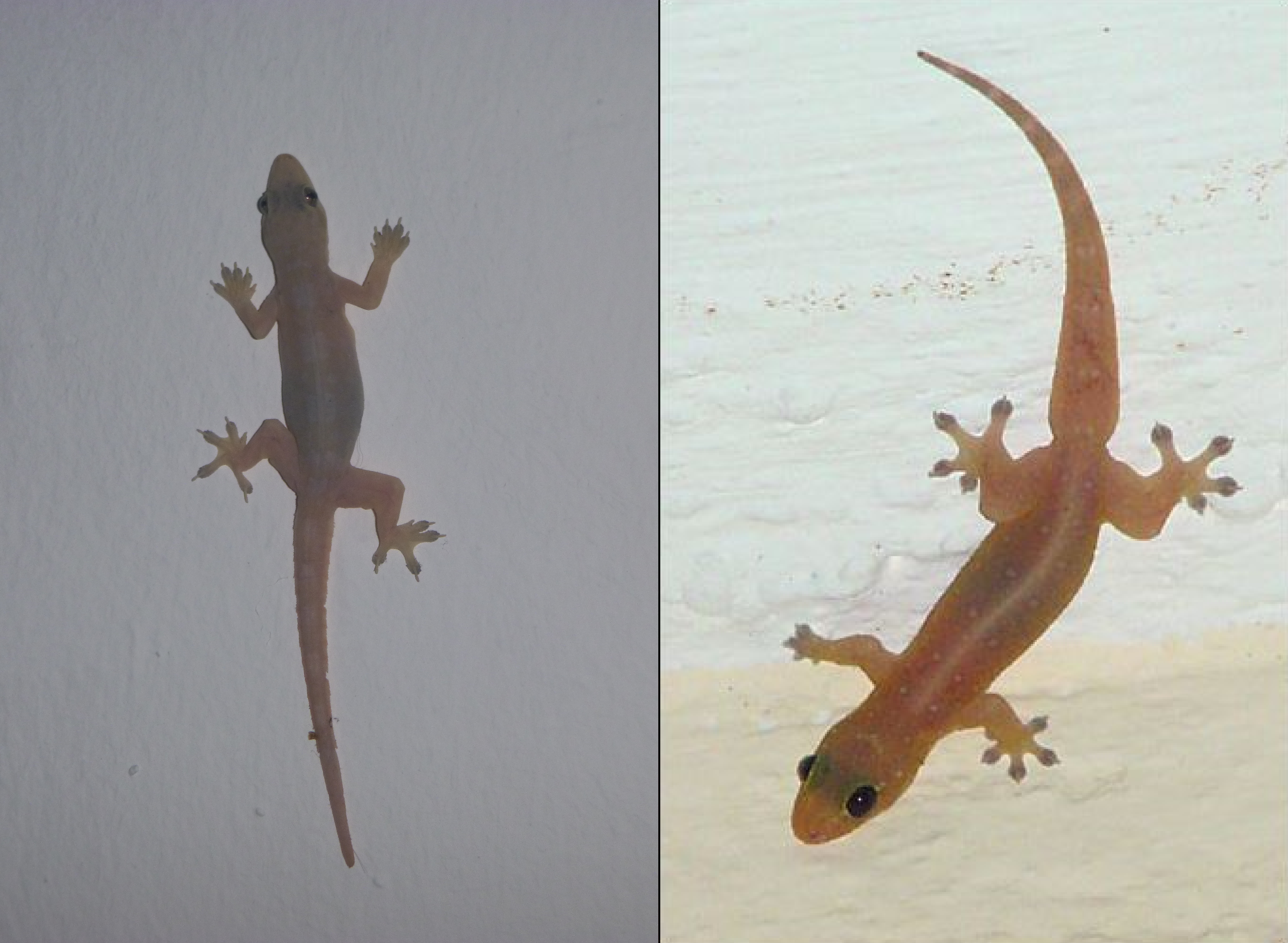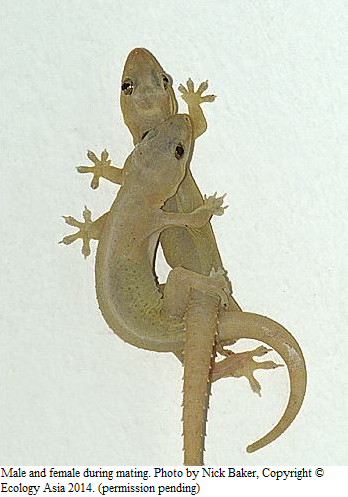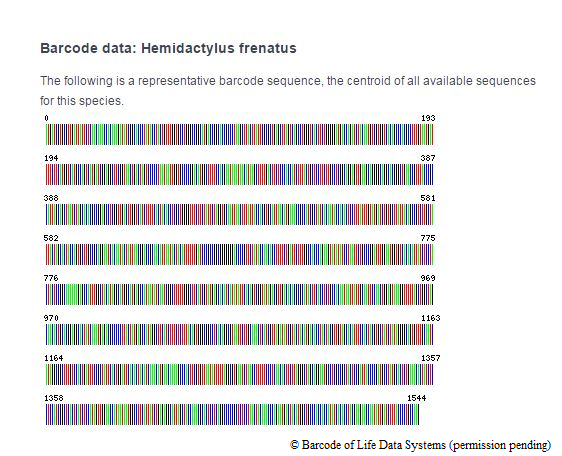Hemidactylus frenatus -Schlegel, 1836.
Table of Contents
Common House Gecko

Photo of Hemidactylus frenatus by Doireann Ferris. Photo of Hemidactylus frenatus, Puerto Vallarta, Jalisco, by ©Petr Myska (permission granted)
Introduction
Hemidactylus frenatus is a reptile belonging to the family Gekkonidae. It is a native species of Southeast Asia and is commonly found in Singapore. It is also known as the Pacific House Gecko, Asian House Gecko, or simply, House Lizard. Hemidactylus frenatus is morphologically most similar to and often confused with the Mediterranean species of the same genus, Hemidactylus turcicus, the Mediterranean House Gecko. Although Hemidactylus frenatus is frequently known as the Common House Gecko. It inhabits many different countries and so it has many more different common names. These names include: Chichak, Bridled House Gecko, Wall Lizard, Spiney-tailed House Gecko, Gewöhnlicher Halbfingergecko, Asiatischer Hausgecko, Limpia Casas, Chee Chak, Chi Chak, Cicak, Butiki, Tiki, Chhipkali, Jing-jok(จิ้งจก), ଝିଟିପିଟି, Palli, பல்லி, টিকটিকি (www1 and www2).
Hemidactylus is the most species rich genus in the family geckkonidae. There are 80 described species of Hemidactylus. More are still being described in recent years. Hemidactylus frenatus is one of the 5 species largely responsible for the large geographical area coverage of the genus Hemidactylus. The others are: Hemidactylus mabouia, Hemidactylus turcicus, Hemidactylus brookii and Hemidactylus garnotii (www1).
Like most geckos, Hemidactylus frenatus is nocturnal. It generally hides during the day and can be seen climbing the walls of houses and other buildings in search of insects at night. It is often attracted to light sources on buildings and can be most easily observed nearby light sources in homes, hence the name –House Gecko (www2).
Description
Hemidactylus frenatus was first described by Hermann Schlegel in Dumeril & Bibron in 1836. Schlegel was a German naturalist whose work consisted mostly of ornithology (the study of birds) and herpetology (the study of amphibians) (www5).
Etymology
Hemidactylus meaning: "half-toe", frenatus meaning: "bridled"(www2).
Holotype
The original holotype specimen is unknown and presumed lost (Sang et al., 2009).
Synonyms
Due to misidentification as separate species, Hemidactylus frenatus has subsequently been identified and named many times. Here are all 43 of the synonyms, their authors and year of identification, as of 2013:
Hemidactylus javanicus FITZINGER 1826
Hemidactylus (Pnoepus) Bojeri FITZINGER 1843
Hemidactylus vittatus GRAY 1845
Hemidactylus punctatus JERDON 1853
Hemidactylus fraenatus BLEEKER 1857
Hemidactylus inornatus HALLOWELL 1861
Hemidactylus pumilus HALLOWELL 1861
Gecko caracal TYTLER 1865
Gecko chaus TYTLER 1865
Hemidactylus longiceps COPE 1869
Hemidactylus hexaspis COPE 1869
Hemidactylus papuensis [MACLEAY] 1877
Hemidactylus tristis SAUVAGE 1879
Hemidactylus frenatus BOULENGER 1885
Hemidactylus nigriventris LIDTH DE JEUDE 1905
Hemidactylus bowringii STEJNEGER 1907
Hemidactylus fragilis CALABRESI 1915
Hemidactylus frenatus DE ROOIJ 1915
Hemidactylus nigriventris DE ROOIJ 1915
Hemidactylus vandermeer-mohri BRONGERSMA 1928
Hemidactylus mabouia BARBOUR & LOVERIDGE 1929
Hemidactylus okinawensis OKADA 1936
Hemidactylus vandermeermohri WERMUTH 1965
Hemidactylus auritus POEPPIG (in OBST) 1977
Pnoepus papuensis WELLS & WELLINGTON 1985
Pnoepus frenatus WELLS & WELLINGTON 1985
Pnoepus bojeri WELLS & WELLINGTON 1985
Pnoepus vittatus WELLS & WELLINGTON 1985
Pnoepus punctatus WELLS & WELLINGTON 1985
Pnoepus inornatus WELLS & WELLINGTON 1985
Pnoepus pumilus WELLS & WELLINGTON 1985
Pnoepus caracal WELLS & WELLINGTON 1985
Pnoepus fragilis WELLS & WELLINGTON 1985
Hemidactylus fragilis LANZA 1990
Hemidactylus frenatus LANZA 1990
Hemidactylus frenatus LINER 1994
Hemidactylus frenatus GLAW & VENCES 1994
Hemidactylus frenatus MANTHEY & GROSSMANN 1997
Hemidactylus frenatus COX et al. 1998
Hemidactylus frenatus COGGER 2000
Pnoepus frenatus WELLS 2002
Hemidactylys cf. frenatus ANDREONE et al. 2003
Hemidactylus cf. frenatus JESTRZEMSKI et al. 2013
(www1).
Distribution
Hemidactylus frenatus is an ectotherm. This means it cannot produce its own heat. It can only survive in places with sufficiently high temperatures. For this reason Hemidactylus frenatus is only distributed in areas of warm climate, in tropical and sub-tropical regions. Its physiological processes are largely influenced by ambient temperature. Despite these restrictions, Hemidactylus frenatus has become one of the most successful reptiles. It is widely distributed across the world. Hemidactylus frenatus is found across tropical Asia and has even formed a stable population in Australia, Africa and the Americas as an invasive species (Lei & Booth, 2014). Hemidactylus frenatus thrives between sea level and 1,600 m above sea level (Spawls et al.,2002).

Habitat
Hemidactylus frenatus is solely terrestrial. It is mostly found where there is human habitation; in cities, urban areas and villages where the lights attract it. It is found on building walls, but also on trees, rotting logs, and on or under boulders. Hemidactylus frenatus is an arboreal species. It can perch at a height of greater than one metre (Crandell et al., 2014). As seen in the photograph below, it can live inside as well as on the outside of buildings.
Biology/Anatomy
The average lifespan of Hemidactylus frenatus is 5 years. It becomes sexually mature at 1 year. Similar to most lizards, Hemidactylus frenatus has four well developed legs, a long tail and a prehensile tongue to catch moving prey (DeVoe, 2015).
The modification of its eyes allows it to can see very well in the dark, the time when it is most active. The eyes are binocular with a low convergence ratio and a high visual cell density. This increases visual sensitivity in the dark (Roll, 2001).
Adult Hemidactylus frenatus can measure between 3-6 inches (975-1500 mm). A significant adaption of its anatomy is the modification of its foot to climb along walls and ceilings. The claws are enlarged and the toes have adhesive toe-pads (Crandell et al., 2014).

All Hemidactylus conserved many primitive morphological features. These include the skull structure and the presence of 26 presacral vertebrae. Some derived features include a laterally expanded un-regenerated tail, enlargement of dorsal scales and the reduction or loss of dorsal tubercles and femoral pores (Carranza, 2006).
Reproduction
Hemidactylus frenatus reproduce sexually. This method of reproduction is key to the success of Hemidactylus frenatus. In Pacific Islands it had been observed that Hemidactylus frenatus, as an alien species, is out-competing the native ecological similar species. The native species is parthenogenetic, this means it reproduces asexually (Dame & Petren, 2006).
Proceeding successful reproduction, Hemidactylus frenatus will produce young. Hemidactylus frenatus is oviparous. This means that it produces its young by laying eggs which will mature and hatch outside the maternal body. As with all reptiles the sex of the young is determined by the environmental temperature. The eggs are layed in crevices for protection against predators. The gecko can produce eggs all year round. Incubation time can range from 53-88 days, depending on geographical location, as warmer temperatures lead to shorter incubation times.Usually 2 eggs are layed at a time. The egg it produces is ten or more times richer in calcium that eggs of birds or turtles (Jenkins & Simkiss, 1968).
It has been demonstrated that for island populations, natural or anthropogenic disturbance of habitat will result in more eggs being layed. This helps safeguard survival of the population (Ineich, 2010).

Feeding/Diet
Hemidactylus frenatus eats a variety of arthropods such as insects and arachnids. It can survive without eating for relatively long period of time due to the morphological and functional plasticity of hepatocytes (de Brito-Gitirana & Storch, 1998).
Temperature has a huge effect on the feeding habits of Hemidactylus frenatus. In the wild Hemidactylus frenatus is unable to feed below the temperature of 17-15 ̊C. In the laboratory Hemidactylus frenatus will stop feeding at 17 ̊C or below. The reason for this, is that at these temperatures or below, Hemidactylus frenatus is unable to digest food. Above these temperatures the efficiency of their feeding does not change with change in temperature (Lei & Booth, 2014).
Behaviour
Hemidactylus frenatus is a nocturnal species. It is non-venomous and harmless to humans. Large individuals may bite if stressed, but the bite is weak and may not even break human skin. Like most geckos, Hemidactylus frenatus can lose its tail when alarmed. It does this in order to distract its predator and escape danger. It emits multiple chirp calls and this sound resembles the word “gecko” repeated 3 times (Marcellini, 1977).
Interspecific Relationships
Hemidactylus frenatus is responsible for the decline in population of 6 species of Nactus gecko and linked with the extinction of 3. These reduction and extinctions occurred after the introduction of Hemidactylus frenatus to the Mascarene Islands. The remainder of these Nactus gecko are limited to small populations on the offshore islets of Mauritius (Arnold, 2000, Cole et al., 2005 and Carranza, 2006).
Conservation Status
Hemidactylus frenatus was last assessed for its conservation status on 30/06/2009. The conclusion of this assessment was that Hemidactylus frenatus is in the category secure, least concern (LC). The justification behind this status is that Hemidactylus frenatus is a widely distributed species, it is commonly found in its habitat, it is not being negatively impacted by any process and populations are not declining. This assessment was carried out by Ota, H. & Whitaker, A.H. for The IUCN Red List of Threatened Species (www4).
Taxonomy
Taxonomy work on the genus Hemidactylus is particularly difficult. Most taxonomic work of DNA sequencing is done on remote small species on remote islands. External features alone are not suitable for taxonomic identification since they are plastic in appearance and often their features appear differently within species and across geo-locations. This results in the difficulty of producing unambiguous identity keys based on morphology (Carranza, 2006).
Classification/Phylogeny
Kingdom: Animalia
Phylum: Chordata
Subphylum: Vertebrata
Class: Reptilia
Order: Squamata
Suborder: Sauria
Family: Gekkonidae
Genus: Hemidactylus
Species: frenatus
(www3).
This figure is adapted from Bauer et al., 2010 it shows the “Phylogeny of tropical Asian and other Hemidactylus geckos.” It is a “Maximum-likelihood topology with parsimony bootstrap, likelihood bootstrap, and Bayesian posterior probability values indicated for each branch”. The position of Hemidactylus frenatus in its phylogenetic tree has been highlighted.
Genome Sequencing
The genome has been partially sequenced for Hemidactylus frenatus and it available at NCBI (National Centre for Biotechnology Information) http://www.ncbi.nlm.nih.gov/nuccore/NC_012902.2

Atrophic Association/ Pet Trade
Hemidactylus frenatus is often used in experiments and as a model for lab testing temperature effects on biological systems (de Brito-Gitirana & Storch, 2002).
In America Hemidactylus frenatus and other geckos are a welcome sight in most houses since it helps to reduce the amount of insects in houses, by eating them (www1).
Hemidactylus frenatus can be kept as pets in a vivarium. In order to keep it as a pet it requires moisture, heat source, live food and clean substrate.
Human activity is largely responsible for the spread of Hemidactylus frenatus from its native area, resulting in its wide range around the world (Carranza & Arnold, 2006 and Jesus et al., 2005).
Superstitions
There are many superstitions regarding geckos. Geckos are falsely considered poisonous in many parts of the world. In Southeast Asia geckos are believed to be carriers of good omen.
In Yemen and other Arab countries, people falsely believe that skin diseases occur from geckos running over the face when someone is asleep.
According to the mashithantu dictionary, in India there is system of predicting good and bad omens based on the sounds made by geckos, their movements and the rare times when they may fall from roofs.
In some parts of India, the sound made by geckos is thought to be a bad omen; whereas in Bangladesh it is considered to be a sign of the truth of whatever statement was made just before the sound, because the sound it makes is similar to "tik tik tik" which, in Bengali means "right right right”.
The noise made by a gecko from an east wall as one is about to go on a journey is thought to be auspicious, but a chirp from any other wall is supposed to be a bad omen. A gecko falling on someone's right shoulder is considered good omen, but a bad one if it drops on the left shoulder.
In Punjab, it is believed that contact with the urine of a gecko will cause leprosy.(www1).
Useful Links
**http://eol.org/pages/793350/overview**
**http://reptile-database.reptarium.cz/**
**http://www.gbif.org/species/5959976**
**http://www.iucnredlist.org/details/176130/0**
http://en.wikipedia.org/wiki/Common_house_gecko
References
Arnold. E. N., 2000, Using fossils and phylogenies to understand evolution of reptile communities on islands, Bonner Zoologische Monographien, Volume 46, Pages 309-323.
Bauer. A. M., Jackman. T. R., Greenbaum. E., Giri. V. B., de Silva. A., 2010, South Asia supports a major endemic radiation of Hemidactylus geckos, Molecular Phylogenetics and Evolution, Volume 57, Issue 1, Pages 343-352.
Crandell. K. E., Herrel. A., Sasa. M., Losos. J. B., Autumn. K., 2014, Stick or grip? Co-evolution of adhesive toepads and claws in Anolis lizards, Zoology.
Carranza. S., Arnold. E. N., 2006, Systematics, biogeography, and evolution of Hemidactylus geckos (Reptilia: Gekkonidae) elucidated using mitochondrial DNA sequences, Molecular Phylogenetics and Evolution, Volume 38, Issue 2, Pages 531-545.
Cole. N. C., Jones. C. G., Harris. S., 2005, The need for enemy-free space: The impact of an invasive gecko on island endemics, Biological Conservation, Volume 105, Issue 4, Pages 467-474.
Dame. E. A., Petren. K., 2006, Behavioural mechanisms of invasion and displacement in Pacific island geckos (Hemidactylus), Animal Behaviour, Volume 71, Pages 1165-1173.
de Brito-Gitirana. L., Storch. V., 1998, Der einfluß von nahrungsentzug auf die ultrastruktur der hepatocyten von Hemidactylus frenatus (Lacertilia: Gekkonidae) mit besonderer berücksichtigung der peroxisomen, Annals of Anatomy – Anatomischer Anzeiger, Volume 180, Pages 193-202.
de Brito-Gitirana. L., Storch. V., 2002, Temperature induced alterations in the liver of wall lizard (Hemidactylus frenatus): morphological and biochemical parameters, Micron, Volume 33, Pages 667-672.
DeVoe. R. S., 2015, Chapter 7 – Lacertilia (Lizards, Skinks, Geckos) and Amphisbaenids (Worm Lizards), Fowler's Zoo and Wild Animal Medicine, Volume 8, Pages 52-60.
Ineich. I., 2010, How habitat disturbance benefits geckos: Conservation implications, Comptes Rendus Biologies, Volume 333, Issue 1, Pages 76-82.
Jenkins. N. K., Simkiss. K., 1968, The calcium and phosphate metabolism of reproducing reptiles with particular reference to the adder (vipera berus), Comparative Biochemistry and Physiology, Pages 865-868.
Jesus. J., Brehm. A., Harris. J., 2005, Phylogenetic relationships of Hemidactylus geckos from the Gulf of Guinea islands: patterns of natural colonizations and anthropogenic introductions estimated from mitochondrial and nuclear DNA sequences, Molecular Phylogenetics and Evolution, Volume 34, Pages 480-485.
Lei. J., Booth. D. T., 2014, Temperature, field activity and post-feeding metabolic response in the Asian house gecko, Hemidactylus frenatus, Journal of Thermal Biology, Volume 45, Pages 175-180
Marcellini. D. L., 1977, The function of a vocal display of the lizard Hemidactylus frenatus (Sauria: Gekkonidae), Animal Behaviour, Volume 25, Part 2, Pages 414-417.
Roll. B., 2001, Gecko vision—retinal organization, foveae and implications for binocular vision, Vision Research, Volume 41, Issue 16, Pages 2043-2056.
Sang, Nguyen Van, Ho Thu Cuc, Nguyen, Quang Truong, 2009, Herpetofauna of Vietnam. Chimaira, Frankfurt, Page 768.
Spawls. S., Howell. K., Drewes. R.C., Ashe. J., 2002, A field guide to the reptiles of East Africa, Academic Press, Page 543.
Websites:
www1: “Hemidactylus frenatus SCHLEGEL, 1836” by Peter Uetz and Jakob Hallermann. Hosted on The Reptile Database: http://reptile-database.reptarium.cz/species?genus=Hemidactylus&species=frenatus (accessed on 4 Sept 2014).
www2: “Common house gecko” 23 October 2014. Hosted on Wikipedia: http://en.wikipedia.org/wiki/Common_house_gecko (accessed on 2 Oct 2014).
www3: “Hemidactylus frenatus — Overview Common House Gecko” 23 October 2014. Hosted on EOL: Encyclopaedia of Life: http://eol.org/pages/793350/overview (accessed on 4 Sept 2014).
www4: “Hemidactylus frenatus” February 2014. Hosted on The IUCN Red List of Threatened Species: http://www.iucnredlist.org/details/176130/0 (accessed on 2 Oct 2014).
www5: “Hermann Schlegel” 30 June 2014. Hosted on Wikipedia: http://en.wikipedia.org/wiki/Hermann_Schlegel (accessed on 23 Oct 2014).